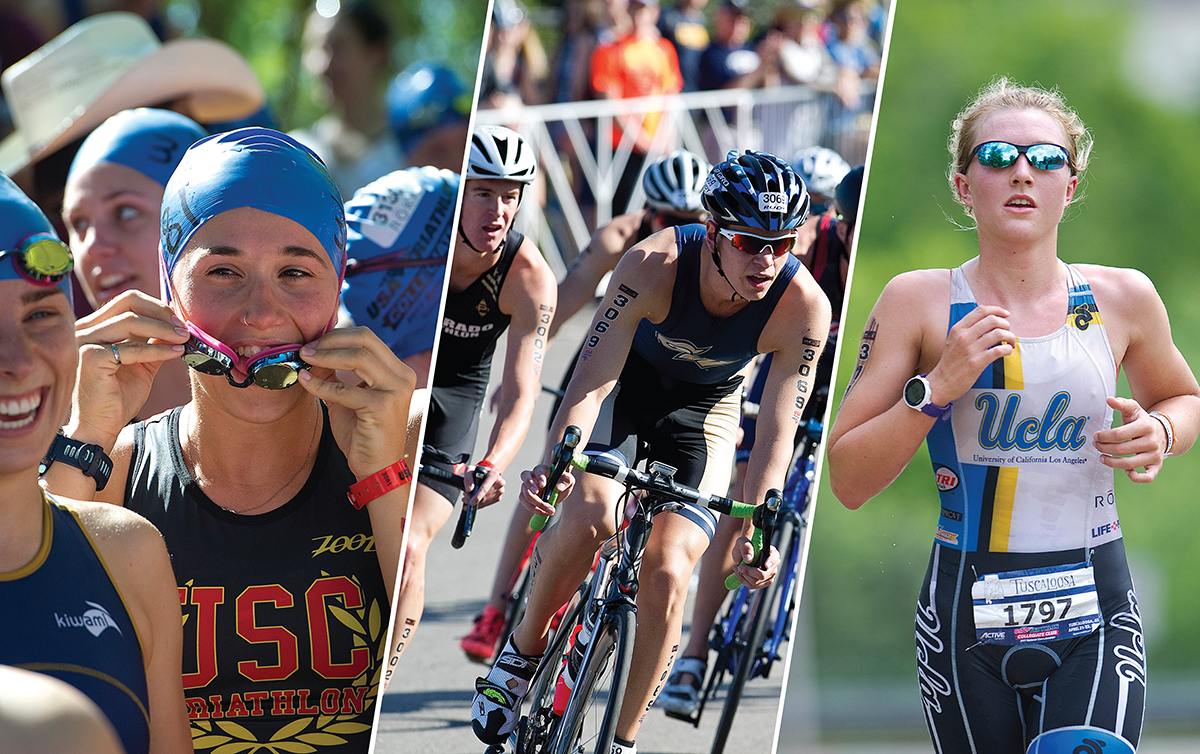With the Covid-19-shortened season (if we can even call it a season!) now in our rearview mirror, it’s time to look ahead to 2021 in the hope upon hope that we will have a full season of races. Being the optimist that I am, I’m expecting that life and triathlon will return to some degree of normalcy, so I’m already planning my winter training program and already hitting it pretty hard in the pool, on my bike, and in my running shoes.
Designing and implementing an effective training program can’t be accomplished until you first know where you want to go next season and figuring out how you are going to get there. Goal setting is a practical mental tool you can use to begin this process and to help you maintain a high level of motivation during the off season.
Goals are very powerful things in our lives. For some very elemental reason, people respond to goals in a very deep and personal way. The experience of setting a goal, working toward a goal, and achieving a goal has a potent emotional resonance that causes us to continue to strive higher for the goals we set for ourselves. Two emotions that are particularly meaningful include pride in putting forth the effort in pursuit of the goal and inspiration in having accomplished the goal.
Aside from the deeper motivational influence that goal setting has on you, it also has real practical value because goals offer two essential things that fuel your passion for triathlon. First, goals provide the destination of where you want to go. This endpoint is important because if you don’t have anywhere you want to go, you can’t get there. Second, having a place you really want to go doesn’t have a lot of value if you don’t know how to get there. Goals provide the road map for getting to your destination.
Keys to Effective Goal Setting
There has been an enormous amount of research, both within and outside of sport, that has studied how goal setting can be used most effectively. The acronym, S.M.A.R.T.E.R. represent the five criteria that this research has found you can use to get the most out of your goal setting.
Specific. Your goals should be specific to what you want to accomplish. For example, you shouldn’t set a goal of getting faster in the water. Instead, you want to identify what aspects of your swimming needs to improve you want to get better at. A more appropriate goal might be: “I want to improve my distance per stroke and 100-yard time.” The more specific you can get, the more you can focus on what you need to do in your training to improve that area.
Measurable. One of the most robust findings from the research on goal setting is that “do your best” goals aren’t very effective because they don’t offer an adequate benchmark to strive for. Instead, you want to set goals that are measurable and objective. For example, returning to the previous example, to swim faster, a good goal could be: “I want to improve my SWOLF by five percent and my Sprint-distance swim time by two minutes.”
Accepted. Ownership of your efforts is essential for your triathlon success and is no less important in the goals you set. Goals that are set by others will not inspire or motivate you fully because they come from outside and you won’t feel real buy-in because they aren’t yours. When you set goals that you believe deeply in, they will be woven into the very fabric of your motivation and you almost have no choice about whether you strive them. Because you own them, you can’t not give your very best effort in their pursuit.
Realistic. You want to set goals that are realistic, but not too realistic. Think of it this way. If you set goals that are too low, they will have little motivational value because you know you’ll achieve the goal without much effort. Conversely, you don’t want to set goals that are too high because you’ll know that you can’t achieve them, so you’ll have little incentive to put out any effort. You want to set goals that are both realistic, but also challenging. Realistic meaning that you can actually achieve them and challenging because your only chance of achieving them is by working really hard. You want your goals to lie just a bit beyond your reach requiring that you really stretch yourself if you want any chance of attaining them.
Time limited. Open-ended goals haven’t been shown to be effective because there is no urgency behind them; you can accomplish the goals when you want. The best goals are ones in which there is a time limit for their achievement. This timeliness acts to incentivize you to work hard right away to meet the time limit. Particularly if the goals are challenging, meaning they aren’t a sure thing, you will feel highly motivated to put in the time and energy necessary to reach them when you have set a deadline to achieve them. For example, if you want to improve your power output, a goal might be: “I’m going to work toward increasing my wattage by five percent by doing 45 minutes of interval training twice times a week for the next six weeks.”
Exciting. Your motivation to strive toward your goals is driven by the emotions you associate with those goals. As a result, you want to set goals that inspire and excite you. These emotions can be the deciding factor in whether you achieve your goals when faced with setbacks, failures, disappointment, fatigue, pain, tedium, and the desire to do other things. As you set goals for yourself, put them to the “excitement” test. Ask yourself whether your goals generate strong and positive emotions in you.
Recorded. Another robust finding in the goal-setting research is that you are more likely to stay committed to the pursuit of your goals when you write them down (not just type them into a computer) than if you just think about them. The benefit appears to be due to several things. First, the physical act of writing your goals appears to somehow imprint them more deeply in your psyche. Second, writing them down also seems to make the goals more tangible and real. Third, the explicitness of writing down your goals seems to create a greater sense of ownership of them, a sense of accountability toward the goals that makes you really feel more compelled to focus on and strive toward your goals. Fourth, a common mistake that many athletes make when they complete their goal setting is to file them away and forget about them. Instead, you should take your written goals and put them up where you can see them regularly, for example, in your bedroom or locker. This constant reminder keeps your goals at the forefront of your mind and, as a result, keeps you focused on accomplishing them.
In addition to these S.M.A.R.T.E.R. criteria, there are several other guidelines that can be beneficial in setting goals that will offer you the maximum benefit.
Focus on progress. Despite the fact that setting goals has been studied for decades and we have a pretty clear picture of why, how, and when it works, goal setting is still an inexact science. What makes goal setting a less-than-precise endeavor is that it involves human beings who are, in general, pretty unpredictable creatures. It is impossible to set goals that you can be sure you can achieve or, if you can achieve them, predict when that will happen. Because of this uncertainty in the goal-setting process, your focus when you set and strive for goals should be progress toward them, not whether you absolutely attain them. Let me explain.
Absolute attainment means accomplishing the goal in its entirety. For example, in working to improve your running, you set a goal of improving your 5K time by ten percent within eight weeks. With absolute attainment, you must meet that improvement goal for you to see yourself as having been successful related to that goal. But, because of the uncertainty of setting goals that I discussed above, adhering to absolute attainment is a recipe for failure. Absolute attainment leaves only a small window for success and a very large window for failure.
Instead, I recommend that you focus on your progress toward your goal. Returning to the running example, if, after eight weeks, you have gotten five percent faster, though your absolute goal wasn’t attained, your improvement would be deemed a success. With a focus on progress, as long as you are showing improvement toward a goal, you are on the right track. After the time frame specified in the goal has been passed, you can then use the information related to your improvement to modify the goal accordingly, either changing the goal outcome or simply extending the time needed to reach the goal. For example, again returning to the running example, because progress was made toward the goal, you have two options. First, you can stick with the goal of a ten-percent improvement and give yourself another four weeks to achieve the goal. Or you can downgrade your goal to, say, seven percent improvement within the next four weeks. In either case, the goal will hopefully continue to motivate you to aim higher and work harder to achieve it.
Make your goals public. Still another result commonly reported in the goal-setting research is that you are more likely to adhere to your goals if you make them public, meaning share them with others. You might do this by showing them to your coach, family, or friends. Or you could post them on your social media for your followers to see. By doing so, not only are you accountable to yourself, but also to everyone with whom you shared them. The upside to making a public declaration of your goals is that you will receive a lot of support and encouragement from those with whom you shared your goals which will motivate you to work even harder as you pursue your goals. The downside is that you might not achieve your goals and have to publicly admit this failure to do so. You may feel some embarrassment for that failure. Hopefully though, you will know that those with whom you share your goals care about and support you regardless of the outcome, so the upsides of public declaration of your goals will outweigh the downsides.
Review your goals regularly. As I noted above, goal setting is an inexact science in which establishing precise goals that are achievable with certainty is difficult. As a consequence, you should view goal setting as a dynamic and ever-evolving process of review, adjustment, and recommitment. You should make it a habit to review your goals on a monthly basis and compare them to your actual progress. It can also be helpful to review them with your coach (if you have one) who can provide useful feedback you can use to make adjustments that will further motivate you to pursue your goals.
Types of Goals to Set
Goal setting involves establishing a series of goals that start big picture and get increasingly specific and actionable.
- Long-term goals: what you ultimately want to achieve in your sport (e.g., a PR, a Kona slot).
- Yearly goals: what you want to achieve this year (e.g., qualifying for age-group nationals, a ranking).
- Performance goals: what results you need to achieve your yearly goals (e.g., finish in top three to qualify for age-group nationals, improve your times in each segment of a race).
- Preparation goals: how you need to train to reach your higher goals (e.g., physical, technical, mental).
- Lifestyle goals: what you need to do in your general lifestyle to reach the above goals (e.g., sleep, eating habits, study habits).
Decide on what you think are reasonable goals using the S.M.A.R.T.E.R. guidelines, as well as the other criteria I described. If you are unsure of the goals to set, I recommend that you sit down with your coach or training buddies and prepare your goals collaboratively as they often have experience and perspective on your development that can help you set the best goals that will motivate you most. The endgame is a goal-setting plan that will progressively and successfully guide you to the performances and results you want.
Do you want to take the next step in training your mind to perform your best in training and on race day? Here are four options for you:
- Read my latest mental training book: Train Your Mind for Athletic Success: Mental Preparation to Achieve Your Triathlons Goals.
- Listen to my Train Your Mind for Athletic Success podcast.
- Take a look at myonline mental training courses.
- Schedule a 1:1 session with me.







